CEP-KAS: Sahel Monitoring March 2023
This fourth monthly analytical report on open source observations of Jihadi activities throughout the Sahel will focus on the most significant events that occurred in March 2023.
The month of March partly coincided with the holy month of Ramadan, which for many extremist and terrorist groups is traditionally the “month of Jihad” in which they exert additional efforts to carry out operations. Throughout the last decade the Islamic State (IS) and al-Qaeda factions worldwide have conducted Ramadan offensives. While this year no significant increase of attacks occurred in the IS heartlands—Syria and Iraq—the Sahel witness a noticeable increase in IS and al-Qaeda operations. Furthermore, since Ramadan began on March 23 and will end on April 20, an increased operations environment must be expected through the month of April.
From February to March, the number of claimed attacks rose about 27 percent, from 41 claims to 52 claims. This likely indicates a future rise in attack claims throughout the rest of the month of Ramadan.
Attacks in the Sahel – General Trends
A compilation of all attacks conducted in the region in 2022 demonstrates an increasingly desperate picture. In 2022, no less than 3,574 incidents were counted, the majority for which JNIM claimed responsibility. The attacks by JNIM in 2022 almost doubled versus the previous year.
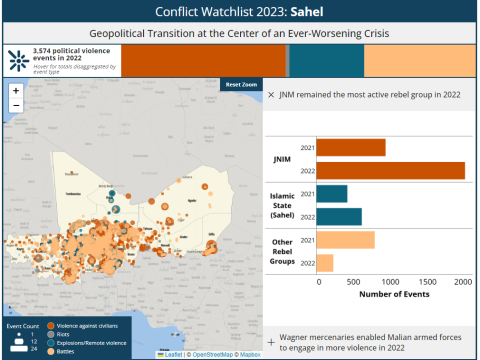
https://acleddata.com/conflict-watchlist-2023/sahel/
Generally speaking, the overall impact of most attacks claimed during March 2023, is rather low, as was the case in previous months. There were, however, a few events that involved dozens of casualties:
- February 17: Attack by ISGS in Burkina Faso targeting the Burkinabe army; Oudalan region; around 70 killed, dozens wounded, and five captured
- February 10: Attack by ISWAP in Nigeria targeting the Nigerian army; region unknown; 45 killed
- February 22: Attack by ISGS in Burkina Faso targeting the Burkinabe army; Oudalan region; dozens killed and wounded
- March 2: Attack by ISGS in Mali targeting JNIM; Menaka region; 40 killed, multiple wounded, and one captured
- March 9: Attack by ISWAP in Nigeria targeting militia; Dikwa region; 45 killed
- Spring: Attack by ISWAP in Nigeria targeting alleged spies and militia; Dikwa region; around 35 killed
Another most remarkable incident is when IS’s an-Naba’ magazine reported on March 2 that a month earlier the Hisba (religious police) captured two “sorcerers” in Tira, Niger. Both men were publicly beheaded, and an-Naba’ published a picture on the executions. IS commonly refers to Qur’an, Sura II “al-Baqara”, verses 101 and 102, to justify beheadings:

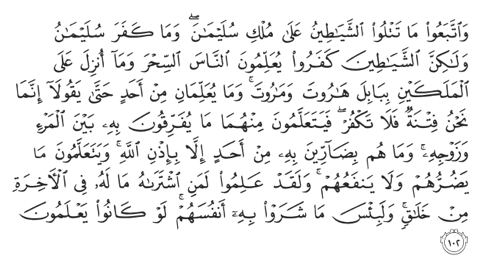
Translation:
Now, when a messenger from Allah has come to them—confirming their own Scriptures—some of the People of the Book cast the Book of Allah behind their backs as if they did not know.
They ˹instead˺ followed the magic promoted by the devils during the reign of Solomon. Never did Solomon disbelieve, rather the devils disbelieved. They taught magic to the people, along with what had been revealed to the two angels, Hârût and Mârût, in Babylon. The two angels never taught anyone without saying, “We are only a test ˹for you˺, so do not abandon ˹your˺ faith.” Yet people learned ˹magic˺ that caused a rift ˹even˺ between husband and wife; although their magic could not harm anyone except by Allah’s Will. They learned what harmed them and did not benefit them—although they already knew that whoever buys into magic would have no share in the Hereafter. Miserable indeed was the price for which they sold their souls, if only they knew!
IS eagerly interprets these two verses as a justification to simply behead anyone who practices a perceived deviant form of Islam or adheres to tribal and popular beliefs. Although the public beheading of the two victims was not the first incident of this kind in the region, it has been a considerable amount of time since IS-linked propaganda outlets published such a gruesome incident.
Attacks Per Country
The highest number of attacks was claimed in Mali with a total of 19 reported incidents. Nigeria comes in second with 18 claims, followed by Burkina Faso at 12. Only two attacks were claimed in Niger and one in Cameroon.
Table 1: Total Number of Attacks
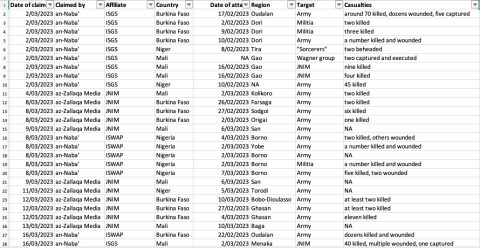
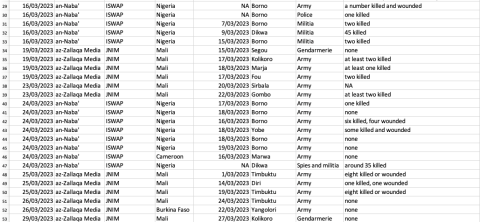
The current situation is so precarious that France’s diplomatic services declared the entire territory of Mali, Chad, Niger, and Burkina Faso no-go zones. The majority of Mauritania also falls under a ban where, in certain areas, the French government formally advises against travel and, in other zones, travel is only advised if there is an important reason. This means that most of the region is deemed insecure by the French government.
Map 2: Security Situation in the Sahel
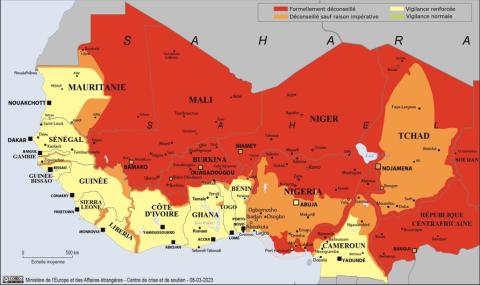
The French government’s assessment is not only based on the significant number of terrorist attacks throughout all countries in the region. Additionally, other security incidents like kidnappings and random killings also occur regularly. For example, in early March two workers for the International Committee of the Red Cross (ICRC) were kidnapped in northern Mali. The ICRC said on Twitter that the abductions took place between the northern cities of Gao and Kidal—a known hotspot for jihadist and militia violence. “We confirm the kidnapping of two of our colleagues this morning … We ask for no speculation about the incident so as not to hinder its resolution,” said the ICRC in Mali.
Attacks by Affiliate:
ISWAP
Half of the deadliest attacks have been claimed by ISWAP. This IS-branch mainly focuses its attacks on government officials or militia supporting the military. In addition, ISWAP continues its brutal campaign against its rival Boko Haram. In early March, it was reported that ISWAP killed more than 200 Boko Haram fighters and their families. Another 560 members of them, including top commanders, fighters and abductees are said to have surrendered to the military.
Table 2: Total Number of Attacks Claimed by ISWAP
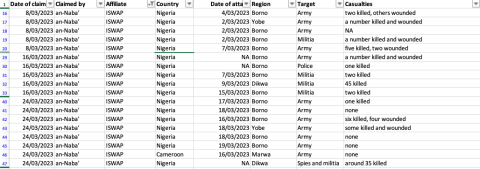
The majority of claimed ISWAP operations concentrated in Nigeria, more specifically in the northeastern Borno Province, close to the border with Chad.
Map 3: Borno Area, Nigeria
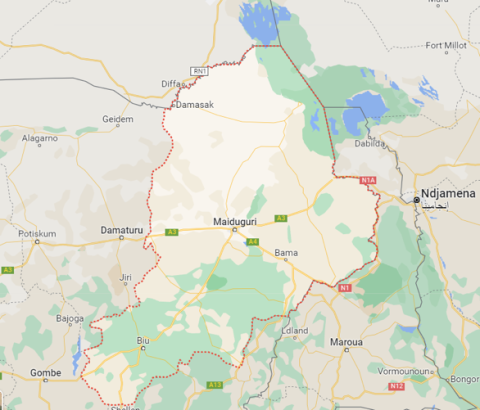
ISGS
Eleven attacks throughout the entire month were claimed by ISGS. Half of the most impactful attacks were claimed by ISGS. One attack was carried out against a camp of JNIM. 40 JNIM fighters were supposedly killed, some wounded, and one captured. Two most remarkable incidents were claimed by ISGS: the execution of two men accused of spying for the Wagner Group and the above-mentioned beheading of two “sorcerers”.
In Burkina Faso, the area of Dori, roughly coinciding with one of the country’s national parks, is a most active region for ISGS attacks. This demonstrates that ISGS is continuously increasing its operational area beyond its heartlands in Mali.


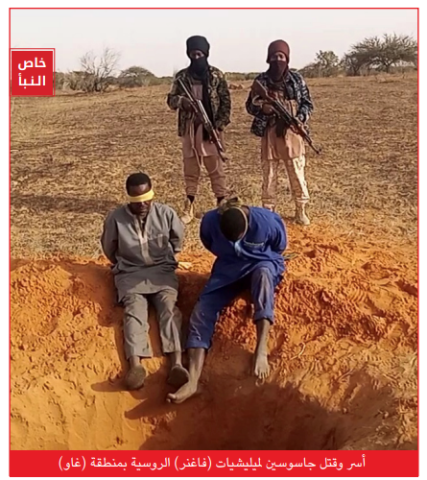
Execution of alleged spies of the Wagner Group
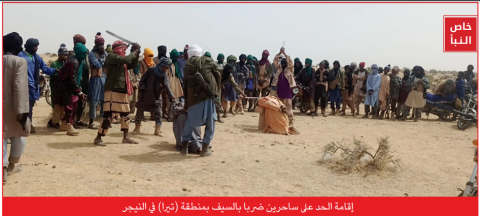
Public beheading of two people for “sorcery”
Map 4: Dori Area, Burkina Faso
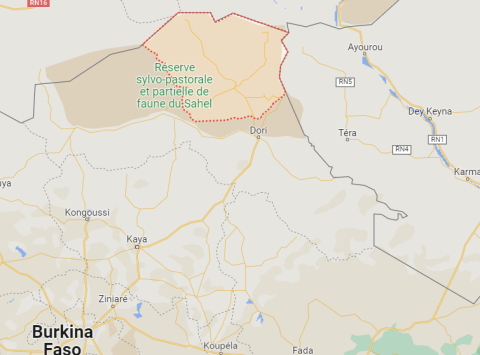
Table 3: Total Number of Attacks Claimed by ISGS

JNIM
JNIM was very active throughout March 2023 with a total of 23 claimed attacks. These concentrated in Mali and Burkina Faso. However, despite this relatively high number of claimed attacks the average casualty rate per attack remained low. All targets were either army or gendarmerie. Unlike the attacks claimed by their IS counterparts, JNIM’s attacks do not focus significantly in any specific region. The attacks are spread out throughout the entire region, with a slight concentration of attacks in Mali, the heartland of JNIM operations.
Table 4: Total Number of Attacks Claimed by JNIM
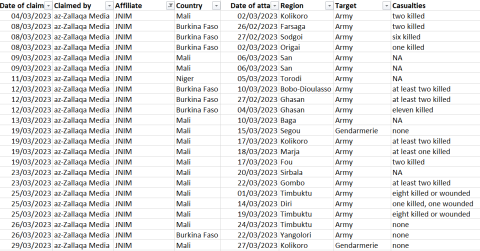
Conclusion
The data compiled in March demonstrates a continuing trend towards ever increasing instability in the Sahel region. The number of violent incidents claimed by terrorist groups continues to increase. The month of March, in particular, saw a sharp increase of reported incidents by 27 percent, compared to February. This is partially due to the start of Ramadan, which traditionally is a month of heightened terrorist activities (March 23 – March 31 or Ramadan 1 – Ramadan 9). It remains to be seen whether this trend will continue during the remainder of Ramadan, which ends on April 20. Nevertheless, as demonstrated in the data concerning terrorist incidents from 2022, the region is increasingly slipping out of control. Several governments in the region have lost the military and political initiative to IS- and al-Qaeda-linked networks operating in their countries and only react to the growing security threat without the ability to reverse this trend. This situation coupled with additional security incidents with a criminal component, such as kidnappings, led to the assessment of the French government that most of the region is no longer safe for travel.
Stay up to date on our latest news.
Get the latest news on extremism and counter-extremism delivered to your inbox.